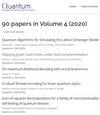Expanding the reach of quantum optimization with fermionic embeddings
IF 5.1
2区 物理与天体物理
Q1 PHYSICS, MULTIDISCIPLINARY
引用次数: 0
Abstract
Quadratic programming over orthogonal matrices encompasses a broad class of hard optimization problems that do not have an efficient quantum representation. Such problems are instances of the little noncommutative Grothendieck problem (LNCG), a generalization of binary quadratic programs to continuous, noncommutative variables. In this work, we establish a natural embedding for this class of LNCG problems onto a fermionic Hamiltonian, thereby enabling the study of this classical problem with the tools of quantum information. This embedding is accomplished by a new representation of orthogonal matrices as fermionic quantum states, which we achieve through the well-known double covering of the orthogonal group. Correspondingly, the embedded LNCG Hamiltonian is a two-body fermion model. Determining extremal states of this Hamiltonian provides an outer approximation to the original problem, a quantum analogue to classical semidefinite relaxations. In particular, when optimizing over the $special$ orthogonal group our quantum relaxation obeys additional, powerful constraints based on the convex hull of rotation matrices. The classical size of this convex-hull representation is exponential in matrix dimension, whereas our quantum representation requires only a linear number of qubits. Finally, to project the relaxed solution back into the feasible space, we propose rounding procedures which return orthogonal matrices from appropriate measurements of the quantum state. Through numerical experiments we provide evidence that this rounded quantum relaxation can produce high-quality approximations.用费米子嵌入扩展量子优化的范围
正交矩阵上的二次编程包含一大类没有有效量子表示的困难优化问题。这类问题是小非交换格罗内狄克问题(LNCG)的实例,是二元二次方程程序对连续、非交换变量的概括。在这项工作中,我们为这一类 LNCG 问题建立了费米子哈密顿的自然嵌入,从而能够用量子信息工具研究这一经典问题。这种嵌入是通过正交矩阵作为费米量子态的新表示来实现的,我们通过众所周知的正交群双覆盖来实现。相应地,嵌入的 LNCG 哈密顿是一个双体费米子模型。确定这个哈密顿的极值态为原始问题提供了一个外近似,这是经典半定量松弛的量子类比。特别是在对特殊的正交群进行优化时,我们的量子松弛服从基于旋转矩阵凸壳的额外的强大约束。这种凸壳表示的经典大小是矩阵维度的指数级,而我们的量子表示只需要线性数量的量子比特。最后,为了将松弛解投射回可行空间,我们提出了舍入程序,通过量子态的适当测量返回正交矩阵。通过数值实验,我们证明这种四舍五入的量子松弛可以产生高质量的近似值。
本文章由计算机程序翻译,如有差异,请以英文原文为准。
求助全文
约1分钟内获得全文
求助全文
来源期刊

Quantum
Physics and Astronomy-Physics and Astronomy (miscellaneous)
CiteScore
9.20
自引率
10.90%
发文量
241
审稿时长
16 weeks
期刊介绍:
Quantum is an open-access peer-reviewed journal for quantum science and related fields. Quantum is non-profit and community-run: an effort by researchers and for researchers to make science more open and publishing more transparent and efficient.
 求助内容:
求助内容: 应助结果提醒方式:
应助结果提醒方式:


